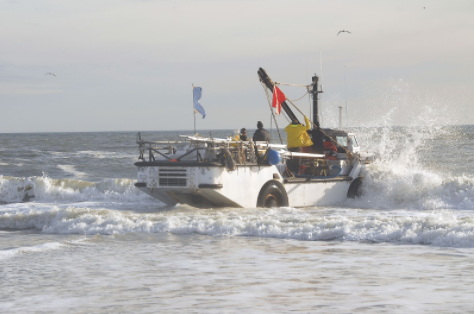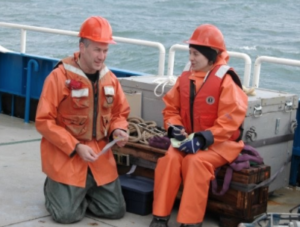
What’s something in your work that always surprises people when you tell them what you do on a day-to-day basis?
Sadly, but not surprisingly, some people are surprised that I am a woman. When I am networking with new contacts and discussing topics online or through email, I am often mistaken for a man (and even called Brandon). This is happening less and less throughout my career, and having an online presence definitely helps, but it is just one example of how women still encounter gender bias in STEM fields.
Many people are surprised that I study physical processes of the ocean, rather than biology, and that I run three-dimensional, Coupled Ocean, Atmosphere, Wave and Sediment Transport (COAWST) models. Many people think about marine mammals when they think of oceanography, and aren’t considering all the interrelated physical, chemical and geologic processes that marine life depends on to survive.
Professionally, people are also surprised I don’t yet have my PhD, which I am starting fall of 2020. There are many excellent career options for students who have not yet, or who have chosen not to, earn their PhD. Students shouldn’t feel pressured into pursuing a PhD right away (or ever) just because “everyone else is”, because it isn’t the right path for everyone. I put a lot of thought into deciding what career success meant for me, which has changed over time, and found that a PhD was not necessarily required to achieve my career goals.
Across all the diversity in ocean engineering, are there any activities or tasks that all ocean engineers have to do?
 Networking and collaboration are really required in ocean engineering because the ocean is connected and spans the entire globe, but also because all ocean disciplines are interconnected. Networking and Collaboration help us leverage the work of other engineers and scientists and reap the creative benefits of diversity, which become a catalyst for advancement. Along those same lines, finding and/or becoming an active,
Networking and collaboration are really required in ocean engineering because the ocean is connected and spans the entire globe, but also because all ocean disciplines are interconnected. Networking and Collaboration help us leverage the work of other engineers and scientists and reap the creative benefits of diversity, which become a catalyst for advancement. Along those same lines, finding and/or becoming an active,
positive mentor and role model (like I have through IEEE Oceanic Engineering Society), helps ensure individual and collaborative success.
What’s something you do every day for your job?
I have to be really creative and tenacious. When I am working to solve a problem I have to be able to look critically at the information I have and come up with a creative solution. Building a realistic ocean model requires:
- Choosing the right numeric model for the problem you’re trying to solve (there are many available and everyone has their favorites) and gaining an in-depth understanding of how the chosen model works.
- Finding or creating the necessary model input (forcing, boundary conditions, initial conditions) and grids (bathymetry, land masking).
- Trial, error and debugging to get the model running.
- Analysis and verification of the model output, which often includes conducting field work so that we have real world (In Situ) data to compare with our model results.
- Iterations and comparisons. In ocean modeling there is always room for improvement, whether you are just running the model with different inputs and settings or writing code to incorporate novel physical, chemical or geologic processes.
What’s one of your favorite parts of your job?
 I really enjoy both developing and testing new inputs, settings and options for the model. It’s particularly satisfying when a new model option or setting leads to improved model results as verified by field data and is visualized in a way that clearly communicates the improvement.
I really enjoy both developing and testing new inputs, settings and options for the model. It’s particularly satisfying when a new model option or setting leads to improved model results as verified by field data and is visualized in a way that clearly communicates the improvement.
Photo credits: Dann Blackwood of the USGS
























